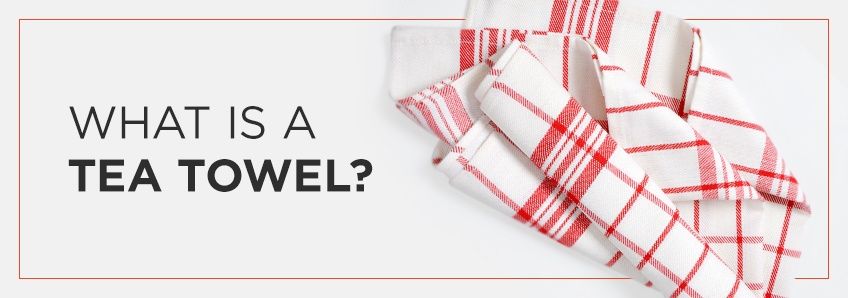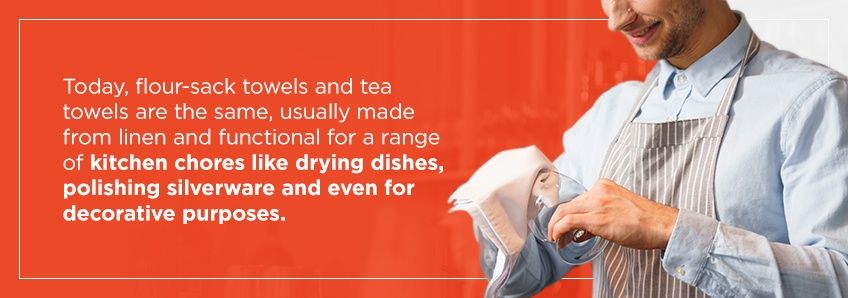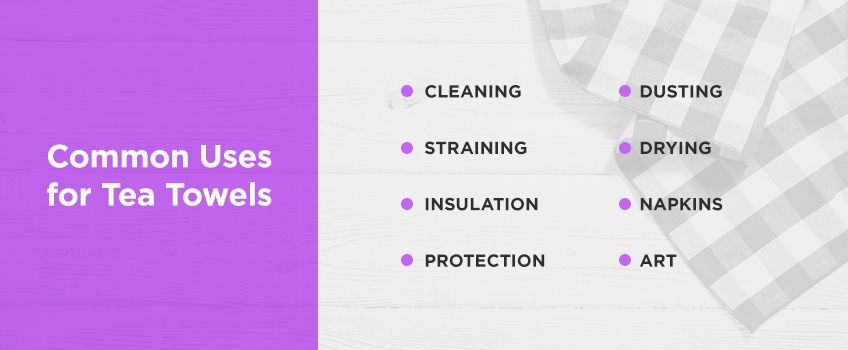What is a Tea Towel?
- Created: Friday, 25 September 2020 12:58
 Kitchen towel, dish towel, flour-sack towel — these are all different names for what is essentially the same item: a tea towel. You may be wondering why there are so many ways to describe this accessory. The answer to that query has more to do with the history of the tea towel than anything else. But before we launch into a quick look at the origins of the tea towel, let's first understand what a tea towel is.
Kitchen towel, dish towel, flour-sack towel — these are all different names for what is essentially the same item: a tea towel. You may be wondering why there are so many ways to describe this accessory. The answer to that query has more to do with the history of the tea towel than anything else. But before we launch into a quick look at the origins of the tea towel, let's first understand what a tea towel is.
Tea Towels and Dish Towels
Tea towels are often interchangeable with dish towels. They're smaller towels used predominantly in the kitchen and food-related uses, including wiping dishes, insulating food and beverage containers and for minor tidying up. Tea towels got their name thanks to their origins in Britain during tea services. People used them to line tea trays, insulate teapots and cover scones and other tea pastries to keep them warm while also keeping pests from settling on them.
Both dish towels and tea towel sizes range from 16 inches by 28 inches to 18 inches by 30 inches. The main difference is in the material. Tea towels are traditionally linen, cotton or a combination of the two, whereas dish towels can be terrycloth. Towels made of terrycloth technically cease being tea towels. Dish towels made of terrycloth are more absorbent and, thus, ideal for drying dishes, while tea towels aren't for absorption alone.
Tea Towels and Flour-Sack Towels
Tea towels and flour-sack towels are more or less the same things now. But back in the early days of the flour-sack towel, during the Great Depression, it was — as its name suggests — a towel made from the sacks in which manufacturers would sell flour, cornstarch and other similar foodstuffs. These flour sacks consisted of tightly woven cloth that was both sturdy and lint-free. These characteristics made them the ideal material to polish delicate cutlery and dishware, since the cloth was soft enough not to leave scratches while being strong enough to properly give cutlery and dishware a good shine. On top of that, they didn't leave any lint behind like many terrycloth rags can.
Repurposing flour sacks became common across America, and homemakers often used these sacks to make kitchen towels as well as other household necessities, including children's clothes, since they couldn't spend money on luxuries like tea towels but still wanted to keep up appearances.
Manufacturers quickly caught on to this trend and began decorating their flour sacks with unique designs and embroidery, which encouraged people to buy their flour with the dual purpose of eventually turning the sack into household linen.
Today, flour-sack towels and tea towels are the same, usually made from linen and functional for a range of kitchen chores like drying dishes, polishing silverware and even for decorative purposes.
A Brief History of the Tea Towel
The origins of the tea towel date back to Victorian-era England, which is where serving tea socially became a common practice. These social tea services used the best dishware and linens, which meant tea towels. Households began customizing their tea towels by embroidering unique designs into the linen or cotton, and these jazzed-up tea towels were popular gifts as well as treasured heirlooms to pass down. They were also the towels the lady of the house used to polish and clean their best silverware and dishware — the pieces reserved for special company and too delicate to entrust to housemaids.
When flour-sack towels started becoming more and more common during the Great Depression, households would continue embroidering flour sacks after carefully cutting them to the size of tea towels. The fact that many people ended up personalizing the flour sacks anyway is partially what inspired manufacturers to begin selling flour in decorated sacks to appeal to the aesthetically minded.
Today, thanks to mass production, tea towels are readily available in all sorts of designs, though their size and material remain more or less the same as in 19th-century Britain. A major difference between then and now is the range of ways people use tea towels today.
Common Uses for Tea Towels
The earliest uses for tea towels, as we mentioned, included maintaining a teatime aesthetic while also keeping the tea and associated delicacies warm. Today, people still use tea towels in this way, but their uses have expanded even more thanks to their availability. Some popular — and inventive — uses for tea towels today include the following.
- Cleaning: Whether it's polishing silverware, drying dishes or cleaning crumbs or spills off a countertop, tea towels are a multifunctional piece of fabric, ideal for any kitchen — personal or professional.
- Straining: Tea towels are an excellent way to strain the water out of freshly washed foods. When you wash lettuce or spinach, let it sit on a tea towel to air dry. Doing so will leave your produce clean and crisp. Similarly, you can find high-quality hand towels to wipe your hands in or around the kitchen.
- Insulation: We already mentioned how tea towels were a popular way to keep tea and food warm, and they can still perform this duty today. If you've made fresh bread and want to keep it warm without getting soggy, wrap it in a tea towel.
- Protection: Tea towels can substitute for oven mitts or an apron when you're in a pinch. Tea towels can also sub in as makeshift bibs or burp clothes for infants.
- Dusting: Tea towels aren't only for kitchen use. Their unique makeup makes them great for dusting. And they're excellent for cleaning windows without leaving a streaky residue.
- Drying: If you're a fan of dehydrating fruits or drying herbs, a tea towel is your best friend. Leave your food on the cloth, which will absorb the moisture for you.
- Napkins: Despite their name, tea towels can shine beyond teatime. Use them as napkins during lunch or dinner, or you can even make yourself a set of placemats out of tea cloths.
- Art: If you're a fan of needlecrafts, like sewing and embroidery, tea towels are a perfect canvas on which to practice your skills if you're a beginner. If you're a pro, you can channel the homemakers of the past and design tea towels using your embroidery skills.
Buy Wholesale Towels From Towel Super Center
At Towel Super Center, we're proud to offer a wide range of high-quality cotton and microfiber towels in various styles and colors to suit every industry and aesthetic. And since we sell the towels wholesale, we can help you save on cost without sacrificing quality.
Browse through our selection of wholesale towels and place your order today.







